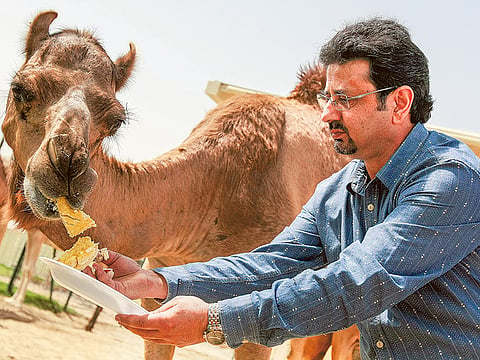World’s first cloned camel, Injaz, celebrates 6th birthday in Dubai
World’s first cloned camel celebrates her sixth birthday with a baby bump in Dubai's Nad Al Sheba

Dubai: Sweeping aside the reservations of cynics, Injaz, the world’s first cloned camel, not only celebrated her sixth birthday at the Reproductive Biotechnology Centre in Nad Al Sheba, Dubai, but showed off her baby bump. Her first calf is due at the end of this year.
The joyous occasion was marked with a special cake that was cut by Dr Nisar Ahmad Wani, Scientific Director of the Centre, along with his team who fed a slice to the doe-eyed beauty.
The Centre, established under the patronage of Shaikh Hamdan Bin Mohammad bin Rashid Al Maktoum, Crown Prince of Dubai, has cloned many camels successfully and has the mandate to apply the latest biotechnological techniques to enhance the production of the animals of this region.
Injaz, meaning achievement in Arabic, marks a milestone in the advancement of cloning and biotechnology in the UAE. The camel was cloned using the ovarian cells of a slaughterhouse camel and since then, more than two dozen camels have been cloned by the Centre which now uses skin cells for cloning.
“Injaz disproved many sceptics who have doubted the fertility of cloned camels as she conceived the natural way,” said Dr Wani, who thinks the successful protocols established at their centre bode well for the international cloning community.
“After Injaz, we have successfully cloned many camels, ranging from racing champions to elite bulls to beauty camels. The cloning technology is being used now through out the world to enhance the production of elite animals and we are applying it to reproduce the best camels. Cloning has great promise for potential gains in biomedicine for pharmaceutical protein production and for multiplication of genetically superior animals and increased production traits,” he said.
Cloning os an effective technique for preservation of endangered species
Cloning also provides a breakthrough in stem cell use for diseases. “The aim of carrying out these studies is to obtain pluripotent cells from a cloned embryo. These cells are genetically the same as the donor organism from which they come. This gives them the ability to create patient- specific pluripotent cells, which could then be used in therapies or disease research,” added Dr Wani, who feels that cloning offers a lifeline to preserving endangered species
“Such cloning of highly endangered or extinct species requires the use of an alternative method of cloning called the interspecies nuclear transfer where we utilise a host and a donor of two different organisms that are closely related species and within the same genus,” he informed
Similar to other assisted reproduction techniques like artificial insemination, multiple ovulation and embryo transfer, it can be used to reproduce only a few selected animals in a similar fashion. According to Dr Wani, people have been using selective breeding from the very start of domestication of animals in order to enhance their production, strength or looks etc.
Explaining the intensive nature of the procedure and its multiple benefits, he added: “We need only a cell from a donor animal to produce its clone. We can culture millions of cells from a pinch of skin and store them in our cell/gene bank for decades. We can use these cells even decades after the death of a donor animal to produce an exact copy of the deceased donor animal. We have established a cell/gene bank in our centre wherein we provide the service of storing the cells from elite animals for their possible future use in cloning.”
Sign up for the Daily Briefing
Get the latest news and updates straight to your inbox


